Private Edwin Douglas Tremble Photographs Digitised @ SLQ
By JOL Admin | 16 October 2015
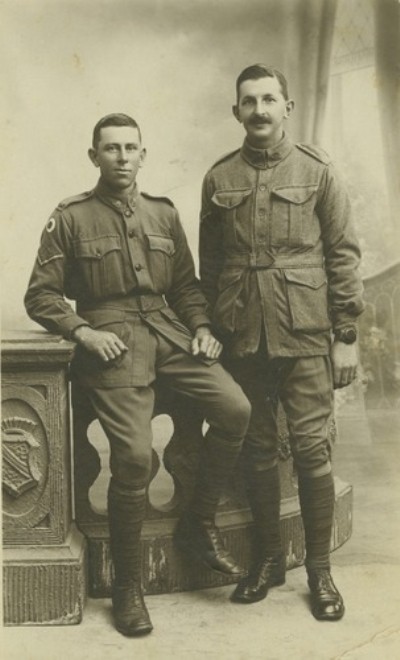
Private Edwin Tremble (right) with Jim Cameron at Fovant Military Camp, Wiltshire, 1917. John Oxley Library, Image No: 29893-0001-0001
A collection of four photographs of Private Edwin Douglas Tremble, from Mackay, has recently been digitised and now appears on our One Search catalogue. The collection was kindly lent to us by a descendant and we are delighted to highlight the war service of another Queensland soldier.
Private Tremble was a 23 year old carpenter from 'The Cedars', North Side Mackay, when he enlisted in the 1st A.I.F. and joined the 5th Reinforcements of the 4th Pioneer Battalion. Edwin was the youngest of eight children. His mother, Elizabeth Tremble (nee Brown) had died tragically in July 1892 following a suicide attempt, and his father Joseph Tremble also lost his life in tragic circumstances in 1912 in a boating accident. According to the Magisterial Inquest held in Mackay, Joseph was accidentally knocked overboard and despite the heroic attempts of his son, Edwin, to save him, he could not be rescued. On his enlistment form Edwin gives his next of kin as his oldest sister Barbara Woodward who was born in Cumberland, England in 1878.
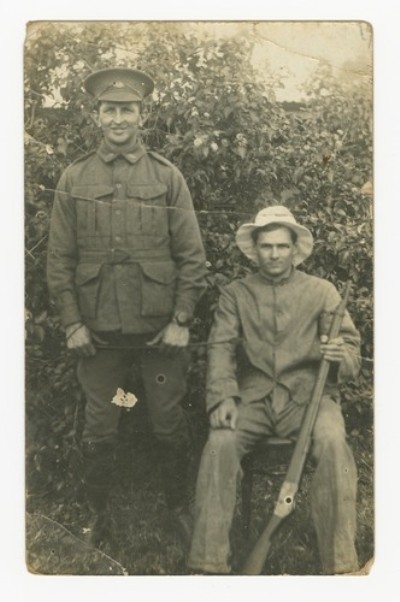
Edwin Tremble and an unidentified Army recruit friend, 1916. John Oxley Library, Image No: 29893-0003-0001
Edwin embarked for overseas service on the 19th September 1916 on the HMAT Seang Choon A49 bound for England. After training at Tidworth Military Camp in Wiltshire he qualified 1st Class at the Musketry School and then joined the 4th Pioneer Battalion in France in September 1917.
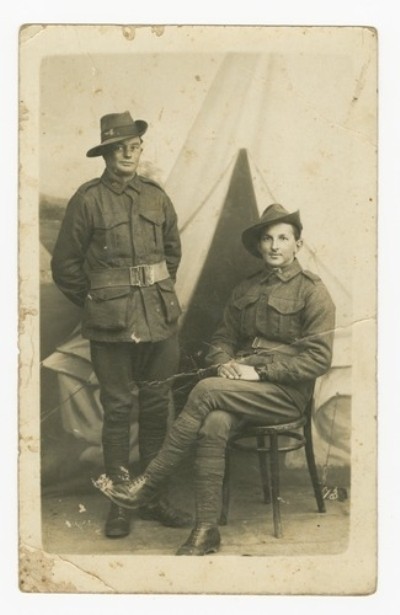
Edwin Tremble with Daniel Johnson, Fovant Military Camp, Wiltshire, England, 1917. John Oxley Library Image No: 29893-0004-0001
The Pioneer Battalions were light combat engineers whose job it was to provide protection for troops through the construction and maintenance of defensive positions, command posts and dugouts. The Pioneers also maintained and repaired roads and railways and constructed barbed wire defences. In addition they provided mobility support to get rations, equipment and troops up to the front lines and to get casualties out. They were trained in both engineering and as riflemen and were thus able to provide support in both a combat and engineering capacity.
The 4th Pioneers were raised during the re-organisation of the A.I.F. in Egypt after the withdrawal from Gallipoli and prior to deployment to the Western Front. They took part in every action undertaken by the 4th Division, including Pozieres, Mouquet Farm, Bullecourt, Messines and also in the Spring Offensive in 1918 at Hebuterne and Dernancourt.
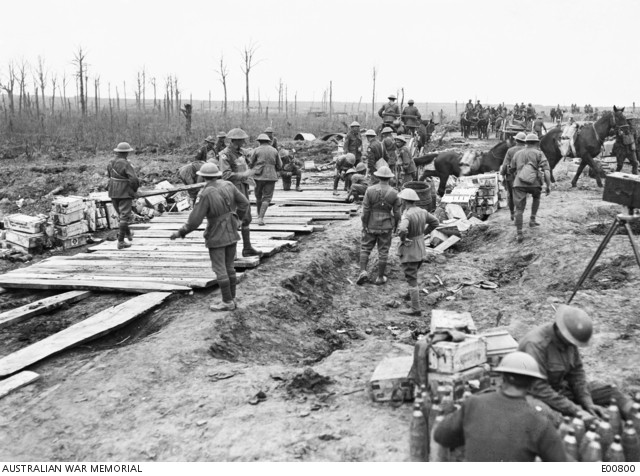
Members of the 2nd Australian Pioneer Battalion making a wagon track from planks at Chateau Wood, Ypres, Belgium, to allow passage into newly captured ground and to facilitate a further advance, 1917. Australian War Memorial: https://www.awm.gov.au/collection/E00800/
In February 1918 Edwin fell ill with trench fever and was hospitalised in France before being transferred to the Graylingwell War Hospital in Chichester, England, in March. Trench fever was a common illness during the war and was transmitted through bites by body lice. Symptoms included headaches, skin rashes, inflamed eyes and leg pains, and victims often had frequent relapses. Edwin also suffered from bronchitis and in July was transferred to the 1st Australian Hospital in Harefield. He did not re-join his unit in France until the 29th September 1918, just before the Armistice was signed on the 11th November.
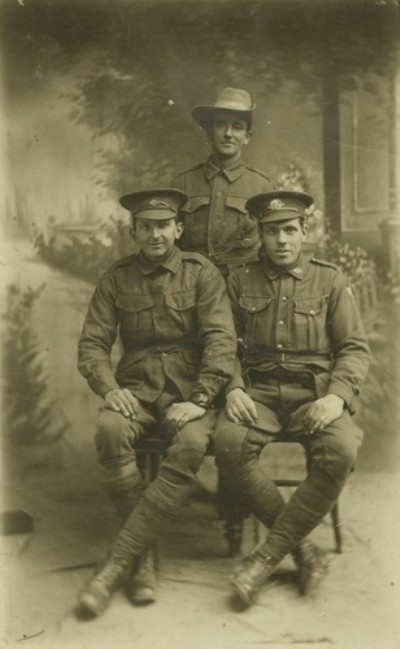
Private Edwin Tremble with two friends, Wiltshire, England, 1917. John Oxley Library Image No: 29893-0002-0001
He returned to England and according to his war records was granted leave with pay to pursue farming activities at Alma Grove, Coombe, near Woodstock, Oxford. He returned to Australia on the 24th October 1919 on board the ship Euripides, disembarking in Sydney. After the war Edwin married Vera Agnes Butler of Ipswich in 1926, and in the Queensland Electoral Rolls is listed as a linesman living at East Ipswich. He died on the 6th August 1950.
The other two soldiers in the photographs also have interesting stories. Private James Cameron was a 21 year old farmer from Yandina at the time of his enlistment on the 29th January 1916 and was assigned to the 4th Pioneer Battalion. Jim embarked on the 1st May on the HMAT Clan McGillivray A46 and was stationed at the Fovant Military Camp in Wiltshire with Edwin. Strangely, on his enlistment papers Jim nominates his next-of-kin as his wife, Mrs. M.M.C.E. Cameron of Kentish Town, London. Perhaps she travelled to London to be close to her husband. In April 1917 Jim was found to have defective vision and was attached to the A.I.F. Administrative Headquarters in London. In early 1918 he was sentenced to 6 months detention for improperly selling an article of regimental clothing; a military greatcoat. He does not appear to have served his entire sentence as he returned to Australia for discharge in May 1918.
Private Daniel Johnson was a surveyor's assistant from Jondaryan, Queensland, and enlisted in Cloncurry at the age of 37. He travelled with Edwin on the HMAT Seang Choon, trained at the Fovant Military Camp and served with the 4th Australian Pioneer Battalion on the Western Front. Johnson was admitted to hospital several times during his war service. In February 1917 he was seriously ill with advanced bronchial pneumonia and was hospitalised in England. In July 1917 he was returned from France to the Devon Military Hospital suffering from trench fever and post pneumonia debility, and in August was in an isolation unit with scabies. In November 1917 he returned to his unit in France and eventually embarked for Australia on the ship Miltiades on the 19th June 1919.
The Edwin Douglas Tremble photographs are available at: http://hdl.handle.net/10462/eadarc/8338
Lynn Meyers, QANZAC 100 Content Curator
Comments
Your email address will not be published.
We welcome relevant, respectful comments.